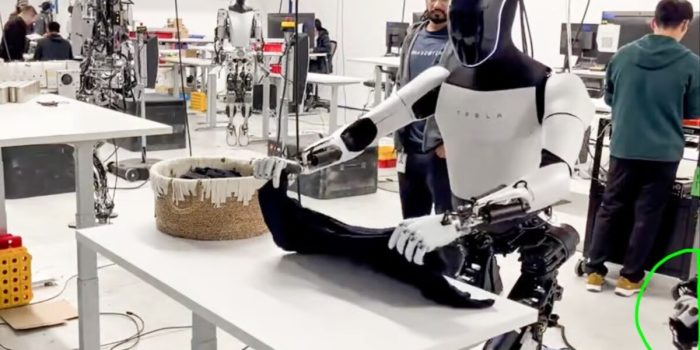Elon Musk recently shared a video of Tesla’s Optimus humanoid robot folding a t-shirt, suggesting a future where robots become household assistants. This comes at a time when many companies aim to introduce humanoid robots into warehouses and factories, replacing human labor in practical tasks. The key challenge for these robots is to move beyond basic skills like walking and balancing and learn to comprehend and execute instructions effectively.
Figure CEO Brett Adcock had previously showcased a significant advancement in humanoid robotics when his company’s 01 robot autonomously operated a coffee machine, learning solely from observing humans performing the task. In response, Elon Musk presented Tesla’s Optimus robot folding a t-shirt, hinting at its potential in handling routine household chores.
However, Musk later clarified in a follow-up tweet that the video was not as groundbreaking as it seemed. The Optimus robot was, in fact, being controlled by a human operator through telepresence, raising questions about the robot’s true autonomy. The distinction between autonomous operation and telepresence is crucial, as genuine autonomy is the ultimate test of a robot’s capabilities.
The confusion surrounding Tesla’s release stems from the fact that Optimus, under human control, displayed impressive fine movements. Yet, the critical question remains unanswered – what can Optimus do on its own? The future holds expectations of humanoid robots acquiring both basic and complex abilities, eventually performing self-directed tasks in dynamic environments.
While Tesla is recognized for its proficiency in AI and autonomy, the current video fails to showcase the robot’s true autonomous capabilities. The focus should shift from what the robot can do with a human operator at the helm to what it can achieve independently.
The development of general-purpose humanoids is still in its early stages, with the real excitement lying in their ability to watch, learn, and adapt to various tasks autonomously.

As the field of humanoid robotics progresses, it is anticipated that more videos will emerge, depicting robots acquiring basic and complex abilities over time. The ultimate goal is for these robots to perform entire self-directed jobs in dynamic and potentially chaotic environments. Toyota’s “large behavior model” progress serves as an example of how embodied AIs are rapidly advancing in their ability to learn by observing humans and running simulations to achieve tasks.
In conclusion, the showcased video of Optimus folding a t-shirt, while impressive in terms of human-controlled movements, falls short in demonstrating the robot’s true autonomy. The focus should be on showcasing genuine autonomy rather than relying on human operators for specific tasks, as humanoid robots progress toward becoming versatile, self-directed entities in various real-world scenarios.


